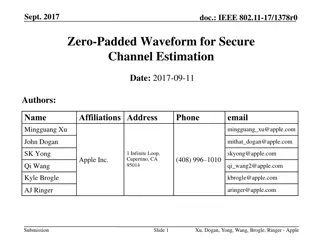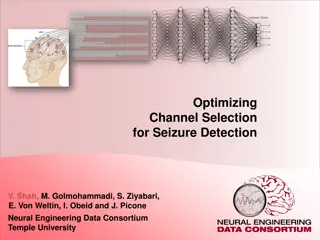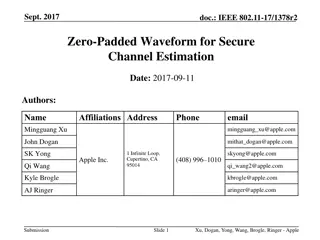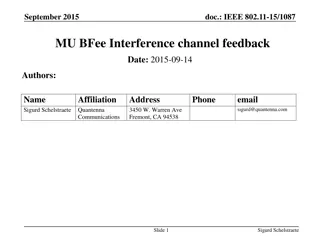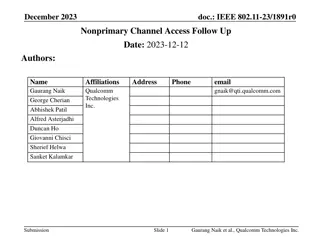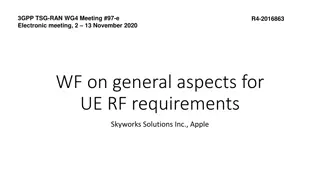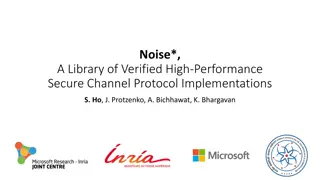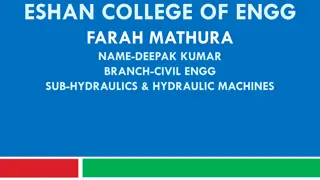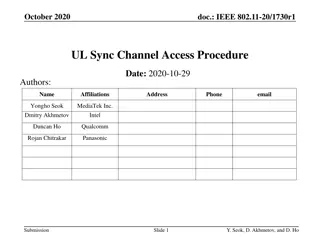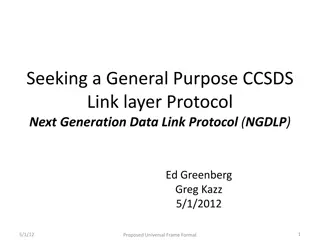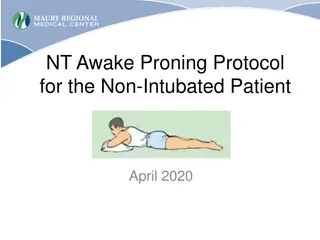Channel Design
Channel design involves creating a plan for the efficient distribution and movement of products and services from the producer to the customer. This process includes determining the channel flow, identifying channel members, setting channel objectives, and developing a channel strategy.
0 views • 13 slides
Sales Leadership Management
Marketing channel decisions play a crucial role in the success or failure of products in both B2C and B2B markets. This chapter explores the importance of effective channel management, types of channels, the role of intermediaries in streamlining transactions, and the distinction between marketing c
0 views • 18 slides
Understanding Channel Design in Marketing
Channel design involves planning the distribution of products and services from producers to customers through different business entities or individuals. It encompasses elements like channel flow, channel members, objectives, alternatives, and strategy. Successful channel design aligns with busines
0 views • 13 slides
ML-Aided Channel Classification for WLAN Optimization
The paper discusses using machine learning to classify IEEE channel models and improve WLAN performance. It demonstrates how neural networks can accurately classify channel types, leading to efficient beamforming and signal processing. Simulation results show the classification performance even at l
0 views • 12 slides
Understanding Mobile Computing and TCP/IP Protocol Suite
Mobile computing is crucial for continuous internet connectivity regardless of physical location. The TCP/IP protocol suite, consisting of Transmission Control Protocol (TCP) and Internet Protocol (IP), forms the backbone of internet infrastructure. IP addressing and mobility challenges are addresse
1 views • 51 slides
Successful Channel Modification Techniques and Benefits
Channel modification projects aim to accelerate the recovery of stable, sustainable channel forms in dynamic balance with sediment, large wood, and flow regimes. Successful modifications lead to improved habitat quality, stability, and diversity, benefiting sediment transport and riparian zones. Phy
0 views • 15 slides
Understanding OSI Model and TCP/IP Protocol Suite in Computer Networking
This chapter explores the OSI model and TCP/IP protocol suite, delving into protocol layers, addressing mechanisms, and network components. It highlights the interface between layers, functions of each layer in the OSI model, and compares TCP/IP protocol suite layers with OSI model layers. The discu
0 views • 30 slides
Effective Channel Management Decisions for Marketing Success
The success of marketing channels lies in making right channel design decisions and effectively implementing them through channel management decisions. From selecting channel members to training and motivating them, companies must focus on building strong partnerships to drive success in the competi
5 views • 6 slides
Understanding Channel Conflict in Marketing
Channel conflict in marketing refers to disputes between different channel partners, such as manufacturers, wholesalers, and retailers, that impact business operations and goals. These conflicts can arise at different levels within the distribution channel, leading to issues like price wars, custome
0 views • 7 slides
IEEE 802.11-20/1761r1 Ranging Protocol for 11bd
This document outlines the ranging protocol proposed for IEEE 802.11-20/1761r1, focusing on RTT-based ranging leveraging multi-channel operation. By integrating the 11az ranging protocol, it enables flexible and low-overhead application in 11bd for improved accuracy in ITS bands. The protocol includ
1 views • 13 slides
Understanding EIGRP: A Comprehensive Overview
Enhanced Interior Gateway Routing Protocol (EIGRP) is a dynamic routing protocol providing various advantages to network administrators. It is a classless routing protocol supporting VLSM and is considered an Interior Gateway Protocol (IGP). EIGRP uses advanced distance vector routing and is known f
1 views • 5 slides
Adapting the 802.11be Channel Model for Modern Doppler Use-Cases
The document discusses the adaptation of the 802.11be channel model to modern scenarios where devices are mobile. It explores the impact of movement on channel models, providing lab measurement results of Doppler Power Spectral Density. The study aims to enhance the evaluation of communication schem
0 views • 16 slides
Tamper-Evident Pairing (TEP) Protocol for Secure Wireless Pairing Without Passwords
This article discusses the challenges of traditional secure wireless pairing methods that rely on password validation and proposes the Tamper-Evident Pairing (TEP) protocol as a secure in-band solution to protect against Man-in-the-Middle (MITM) attacks. TEP eliminates the need for out-of-band chann
1 views • 40 slides
Understanding SFTP Server Functionality with ACS 5.x by Mohammad Azharuddin AAA Team
SFTP (SSH File Transfer Protocol) is a secure network protocol for file access, transfer, and management over reliable data streams. It enhances security by extending the SSH protocol and can be implemented using a reliable 8-bit byte stream protocol. SFTP commands are sent as 4 ASCII letters follow
4 views • 23 slides
The THz Channel Model in Wireless Data Center
This contribution presents preliminary THz channel modeling results for future wireless data center scenarios. Ray tracing simulations are conducted for various channel types, utilizing RMS delay spread and RMS angular spread to measure multipath richness. A stochastic channel model is developed and
0 views • 33 slides
PDSCH Demodulation Parameters & Requirements Discussion
This document covers the discussion on PDSCH demodulation parameters and requirements for UE demodulation and CSI reporting in FR2 DL 256QAM, specifically focusing on static channel mode, TDL-D channel mode, and TDL-A channel mode. The document also explores rank options, channel bandwidth, PRB allo
0 views • 9 slides
IEEE 802.11-24/0858r0: Key Concepts on NPCA and Virtual APs
This document discusses key concepts related to NPCA (Neighbor-Primary Channel Announcement) and Virtual Access Points (APs) in the context of IEEE 802.11 standards. It covers topics such as multiple BSSID sets, co-hosted APs, NPCA primary channel configurations, and criteria for channel switching.
0 views • 9 slides
Instant Communications in Emergency Situations: Clear Channel Network Protocol
The Gulf Coast of Texas faces frequent tropical storms and hurricanes, requiring clear communication strategies. Clear Channel's network of digital units provides vital messaging during emergencies, ensuring public safety. The network protocol involves coordinating messages with emergency management
0 views • 22 slides
802.11aj 45 GHz Channel Access and BSS Operation Framework Proposal
This document outlines a proposal for channel operation and BSS operation in the 45 GHz frequency bands for 802.11aj in China. It includes details on channelization, spectrum allocation, maximum transmit power, and BSS configuration rules. The aim is to meet the functional requirements specified whi
0 views • 32 slides
Further Considerations on Advanced Channel Coding for 15.4ab
This document submitted to the IEEE P802.15 Working Group discusses the importance of advanced channel coding for IEEE 802.15.4ab standard to achieve higher throughput and reliability. It outlines technical guidance on proposed solutions, safeguards, interference mitigation techniques, and backward
0 views • 14 slides
Enhancing Secure Channel Estimation with Zero-Padded Waveforms in IEEE 802.11-17
Secure channel estimation is crucial for protecting against attackers in wireless networks. This document discusses the use of zero-padded waveforms to safeguard ranging waveforms and mitigate CP-replay threats in IEEE 802.11-17 standard, enhancing security and performance in channel estimation.
0 views • 12 slides
Proposal for Improved Channel Access Efficiency in IEEE 802.11 Networks
The proposal addresses the inefficiencies in utilizing secondary channels in IEEE 802.11 networks, aiming to enhance access to wideband channels (>20 MHz) when the primary channel is busy. It introduces a mechanism for APs and STAs to access available secondary channels while the primary channel is
0 views • 7 slides
IEEE 802.11-24/0070r1 Presentation on Non-Primary Channel Access
This presentation discusses the concept of using secondary channels for PPDU transmission in IEEE 802.11 networks to improve efficiency in large bandwidth scenarios. It covers topics such as channel access, backoff mechanisms, and channel switching thresholds. Design principles emphasize minimal imp
0 views • 15 slides
Proposed MAP Channel Access Procedures in IEEE 802.11-24/72r0
In the May 2024 document IEEE 802.11-24/72r0, a uniform MAP coordination framework is discussed, involving procedures like M-AP discovery, coordinated transmissions, and channel access mechanisms. All APs in a coordination group can compete for channel access and share transmission opportunities. Th
0 views • 10 slides
Optimizing Channel Selection for Seizure Detection with Deep Learning Algorithm
Investigating the impact of different channel configurations in detecting artifacts in scalp EEG records for seizure detection. A deep learning algorithm, CNN/LSTM, was employed on various channel setups to minimize loss of spatial information. Results show sensitivities between 33%-37% with false a
0 views • 12 slides
Enhanced Distributed Channel Access (EDCA) for Non-Primary Channel in IEEE 802.11
Discussion on implementing EDCA for Non-Primary Channel Access (NPCA) in IEEE 802.11, focusing on mitigating frame collisions and enhancing medium efficiency. Various considerations for EDCA procedure on the Non-Primary Channel (NPCH) are explored to optimize channel access and reduce wastage. Topic
0 views • 13 slides
IEEE 802.11-23/1935r0 - Secondary Channel Usage Discussions
Explore the discussions on secondary channel usage in IEEE 802.11-23/1935r0, including topics like RU index, BW negotiation, avoiding medium synchronization loss, and single/multiple secondary backoff 20MHz channels. Discover insights on non-primary backoff 20MHz channel locations, transitioning del
0 views • 15 slides
Understanding Protocol Deviations in Clinical Trials
Protocol deviations are expected occurrences in clinical trials that may arise from site or participant actions. It is crucial for research teams to identify, report, and learn from these deviations to ensure the integrity and safety of the study. Mechanisms for identifying and reporting deviations,
0 views • 16 slides
Dynamic Channel Switch Operation in IEEE 802.11-24 Standard
STAs in IEEE 802.11-24 can dynamically switch to secondary channels per the AP's request for frame exchanges. The process involves soliciting control frames, determining parking channels, managing frame exchanges, and switching back to the primary channel at the end of a TXOP. Various examples illus
1 views • 11 slides
Zero-Padded Waveform for Secure Channel Estimation in IEEE 802.11-17
Security is a vital aspect in IEEE 802.11az, particularly in secure ranging applications. This document introduces zero-padded waveforms to protect channel estimation against attackers aiming to manipulate the range of STAs. The proposal outlines requirements, including the need to eliminate predict
0 views • 12 slides
Channel Generation Process for IEEE 802.11aj (45GHz) Based on Channel Measurement
This presentation by Haiming Wang and team from SEU/CWPAN discusses the process of channel realization and generation in the 45 GHz bandwidth. It covers the generation of the channel impulse response, modeling of parameters, statistical measurements, and future work related to the 802.11ad standard.
0 views • 27 slides
IEEE 802.11-15/0364: Channel Estimation Considerations in Wi-Fi Standards
Channel estimation in IEEE 802.11 standards, such as 11n, 11ac, and 11ax, is crucial for efficient MIMO systems. The noise impact during data reception affects the quality of the channel estimate, leading to SNR reduction post-equalizer. Techniques like channel smoothing and averaging of training se
0 views • 11 slides
Managing Channel Information for Wireless Communication Systems
This document from September 2015 discusses issues related to updating channel information in wireless communication systems, focusing on MU-MIMO and TxBF precoding techniques. It explains the challenges of channel aging, the importance of refreshing channel information, and the impact of different
0 views • 16 slides
Enhancing Spectral Efficiency Through Nonprimary Channel Access in IEEE 802.11
IEEE 802.11 is exploring nonprimary channel access to address underutilization of spectrum and improve latency and throughput. This approach involves enabling nonprimary channel access with simple modifications to existing rules, such as limiting TXOP duration and using control frames for coordinati
0 views • 13 slides
Overview of UE RF Requirements for 35/45MHz Channel Bandwidth in 3GPP Meeting #97-e
The document discusses the introduction of 35/45MHz channel bandwidth in UE RF requirements for various bands. It covers equation-based requirements and limitations in UL configurations based on bandwidth allocation. The scope includes capturing content from the first round discussions and clarifyin
0 views • 16 slides
Understanding Noise*: A Verified Secure Channel Protocol Library
Explore Noise*, a library of high-performance secure channel protocol implementations that have been verified for correctness. The Noise protocol examples, such as IKpsk2, showcase key exchange patterns used in applications like WhatsApp and Wireguard VPN. Discover the importance of verified impleme
0 views • 18 slides
Understanding Open Channel Hydraulics: Types of Channels, Flows, and More
Gain insights into open channel hydraulics covering topics like types of channels, various flows, velocity distribution, discharge mechanisms, and economical channel sections. Delve deeper into specific energy, hydraulic jump, gradually varied flow, and the distinction between steady/unsteady and un
0 views • 11 slides
UL Sync Channel Access Procedure in IEEE 802.11-20/1730r1
The document discusses the UL sync channel access procedure in IEEE 802.11, focusing on the conditions under which an STA affiliated with an MLD can initiate transmission, manage its backoff counter, and follow specific rules for accessing the channel. It proposes a straw poll to gather support for
0 views • 8 slides
Seeking a General-Purpose CCSDS Link Layer Protocol: Next-Generation Data Link Protocol (NGDLP)
This document discusses the proposed Universal Frame Format for a next-generation data link protocol, focusing on major questions about transfer frames, Protocol Link Transmission Unit (PLTU), and Universal Transfer Frame Structure. It explores topics such as frame formats, telemetry transfer frames
0 views • 24 slides
NT Awake Proning Protocol for Non-Intubated Patients
This protocol outlines the benefits and procedure for prone positioning in non-intubated patients experiencing mild to moderate hypoxemia. It highlights patient eligibility criteria, equipment required, and considerations for nursing care. The protocol emphasizes improving oxygenation by promoting a
0 views • 11 slides




















